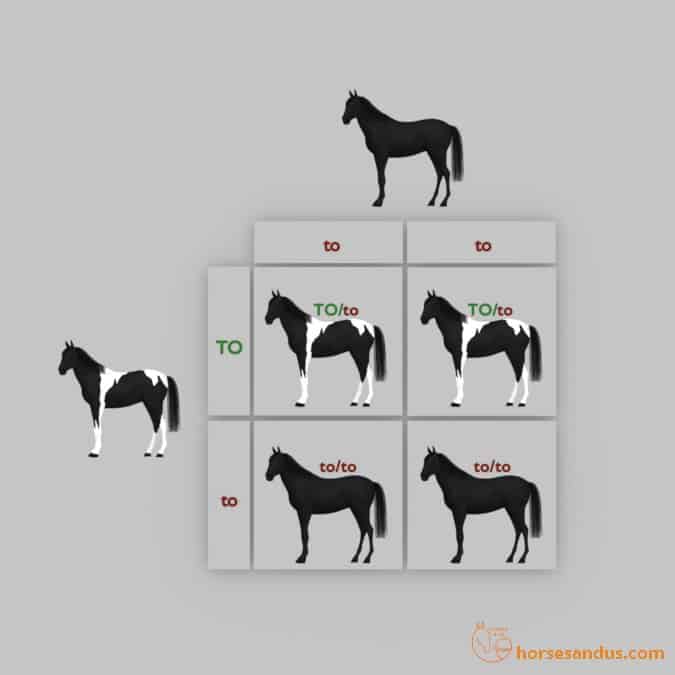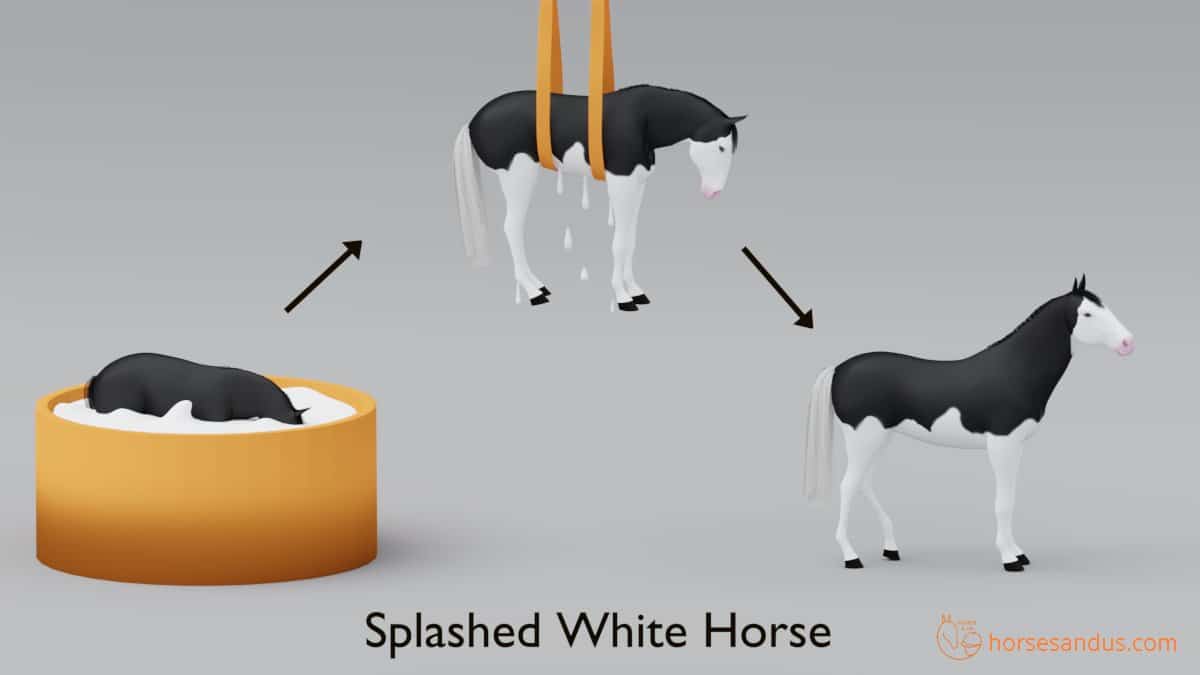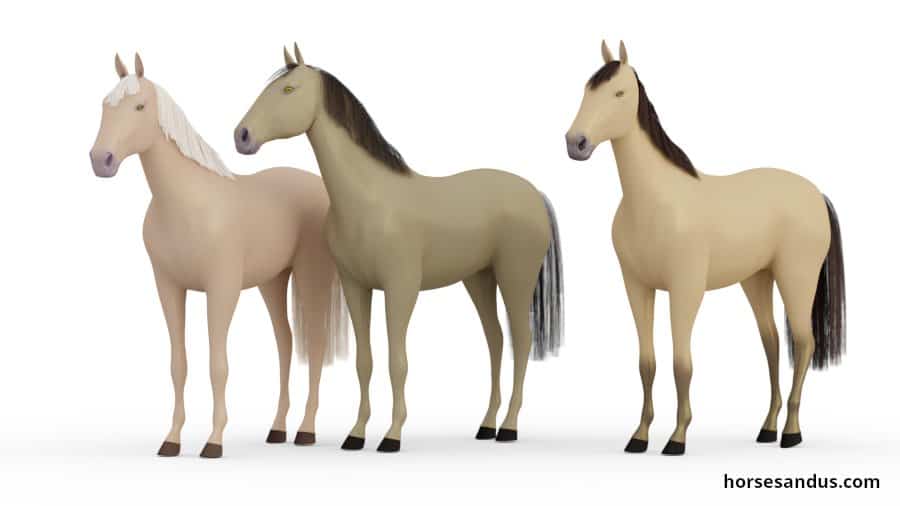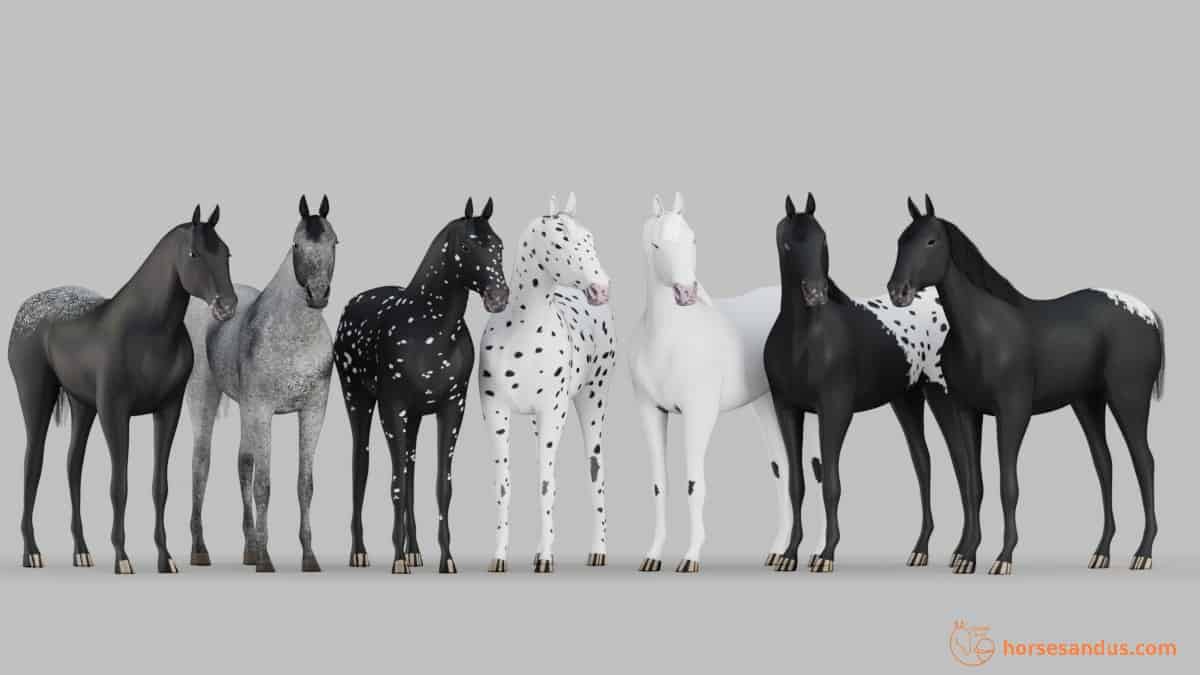The Tobiano horse pattern is characterized by large white areas across the topline that extend downward in a vertical pattern, usually leaving the head, chest, and flanks colored. The edges of the white spots are generally regular and smooth.
A horse with this pattern will look as if white paint has been dropped over it.
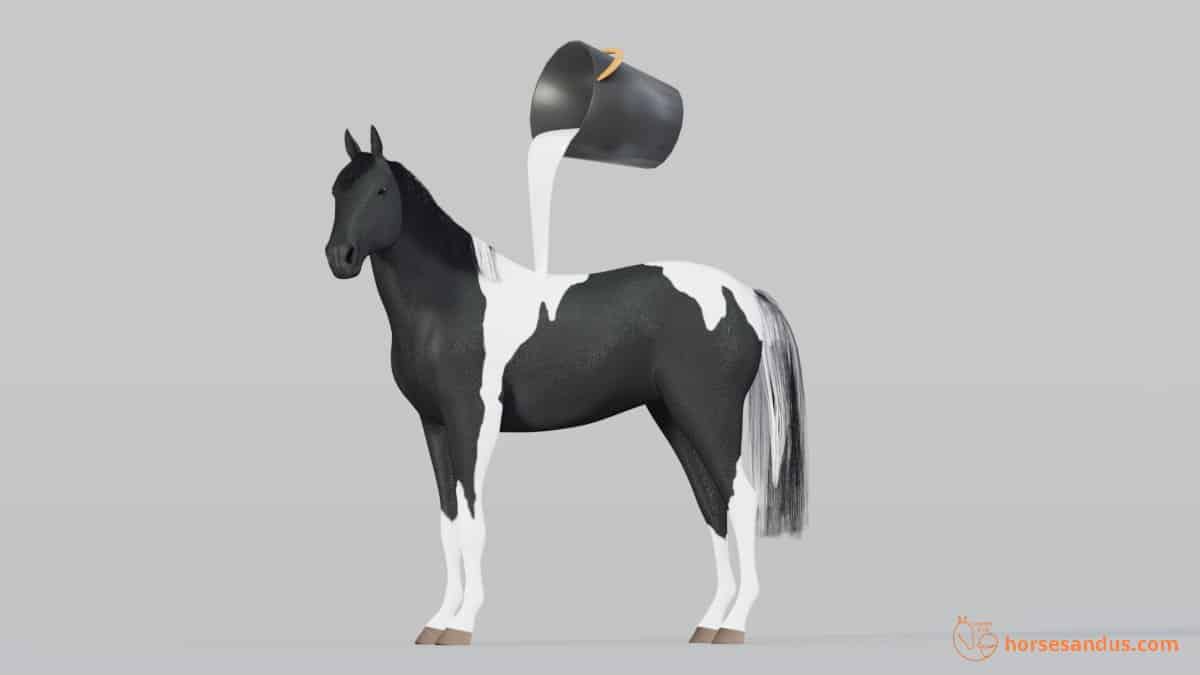
The Tobiano white pattern is one of the most common and easiest patterns to recognize so much that every white pattern that was not recognized as Tobiano was thrown into the generic category “Overo.”
When Tobiano was mixed with any other white pattern it would simply be called “Tovero”.
The white patterns from the Overo family are Frame, Sabino, and Splashed White.
There is a wide variety of horse colors and patterns. In this article, we will look at the patterns produced by the Tobiano gene.
Characteristics Of Tobiano Horses
The following characteristics will help you identify a Tobiano horse
- The white patches are located over the topline and extend downward, usually leaving the head, chest, and flanks colored.
- The edges are rounded and smooth.
- The legs are usually white, at least below the knees and hocks.
- Typically the head is colored but can also have the common white markings.
- The mane and tail are often of two colors, white + base color. This characteristic is unique to the tobiano pattern, and it is rarely seen in other patterns.
- The eyes are usually brown but occasionally can be blue.
- Often, in homozygous Tobianos, there will be:
- small round colored spots within the white areas called “ink spots.”
- smudgy roan colored patches within white areas called “paw prints” or “cat tracks.”
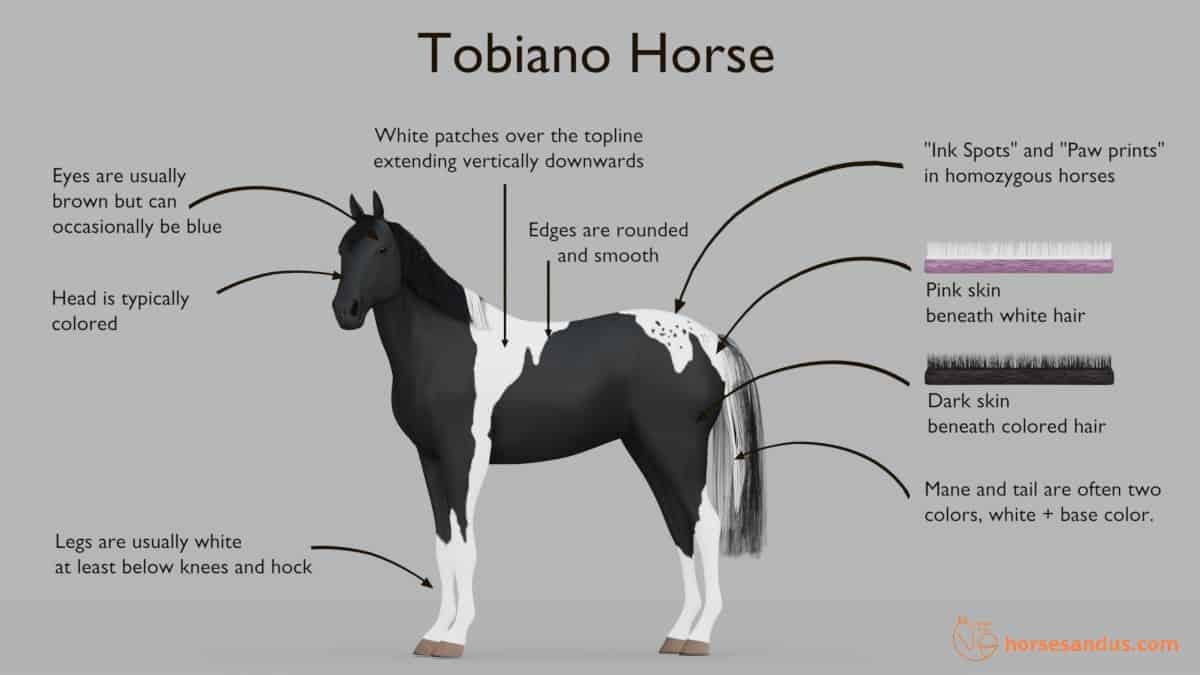
The Tobiano pattern can occur with any base coat color (black, chestnut, bay) or diluted coat color (dun, cream, silver, or champagne).
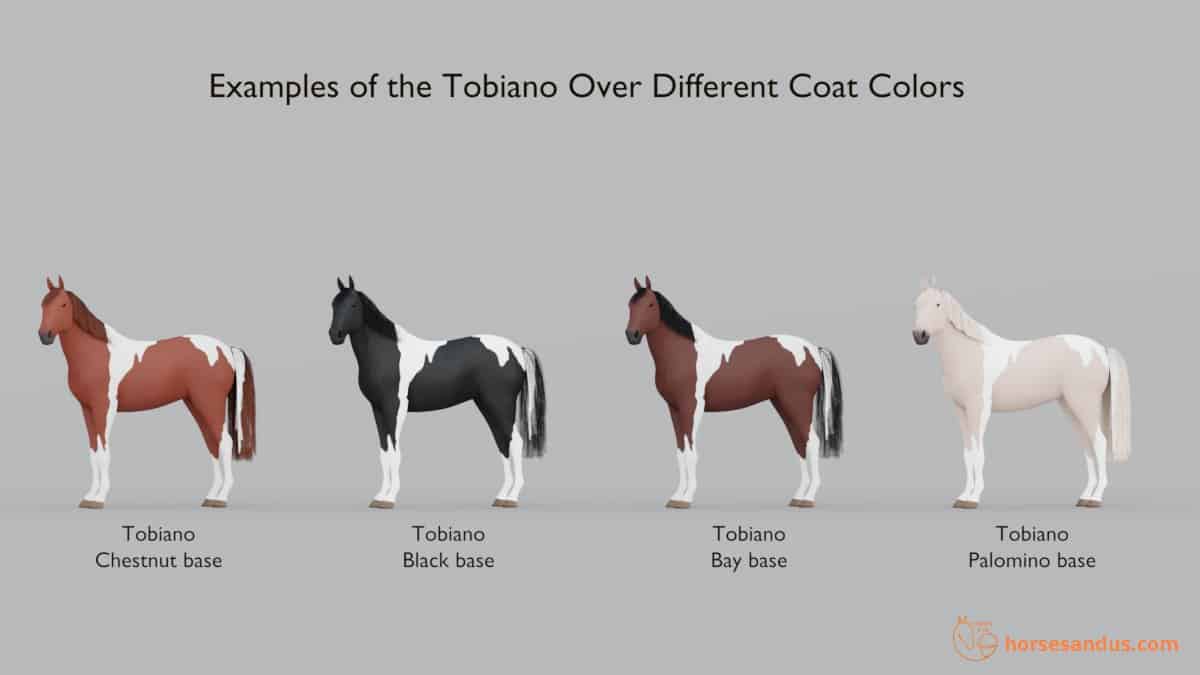
It can also exist in conjunction with other white patterns (Frame, Sabino, Splashed White, Dominant White, Leopard Complex, or Roan).
Tobiano horses can also progressively whiten as they age, due to the action of the Grey gene.
Variability Of The Tobiano Pattern
Similar to other patterns the expression of the Tobiano pattern can vary a lot.

A Tobiano horse can either be mostly colored with small white patches (minimal expression) or the opposite, i.e., mostly white with small patches of color. (Extensive expression) and anywhere in between. So basically, we have three categories:
Minimal Tobiano: will show white on the legs, even though the head is colored. This is a clue to identify them as tobianos because this combination is unusual. Normally the typical white markings on solid-colored horses have a similar amount of white on legs and face.
Minimally marked tobianos can also have small patches of white somewhere along the topline, frequently in the mane or tail.
Medium Tobiano: the pattern with medium expression is very easy to identify as a Tobiano because they show all the characteristic spotting of this pattern.
Extensive Tobiano: are tobianos that are almost completely white, with the exception of the head which is colored.
Some extensively marked Tobianos can have small colored patches in the flanks or on the chest.
Calico Tobiano Horse
Calico Tobiano is very rare and occurs when Tobiano and Cream genes are combined. It can be found in Buckskin Tobiano and Palomino Tobiano Horses.
In these cases, the white pattern is the usual tobiano but some colored areas of the body will be diluted by the cream gene while other areas are left with the base color (red or dark tan). This results in a distinctive patchy tricolored coat, similar to that of a Calico Cat.
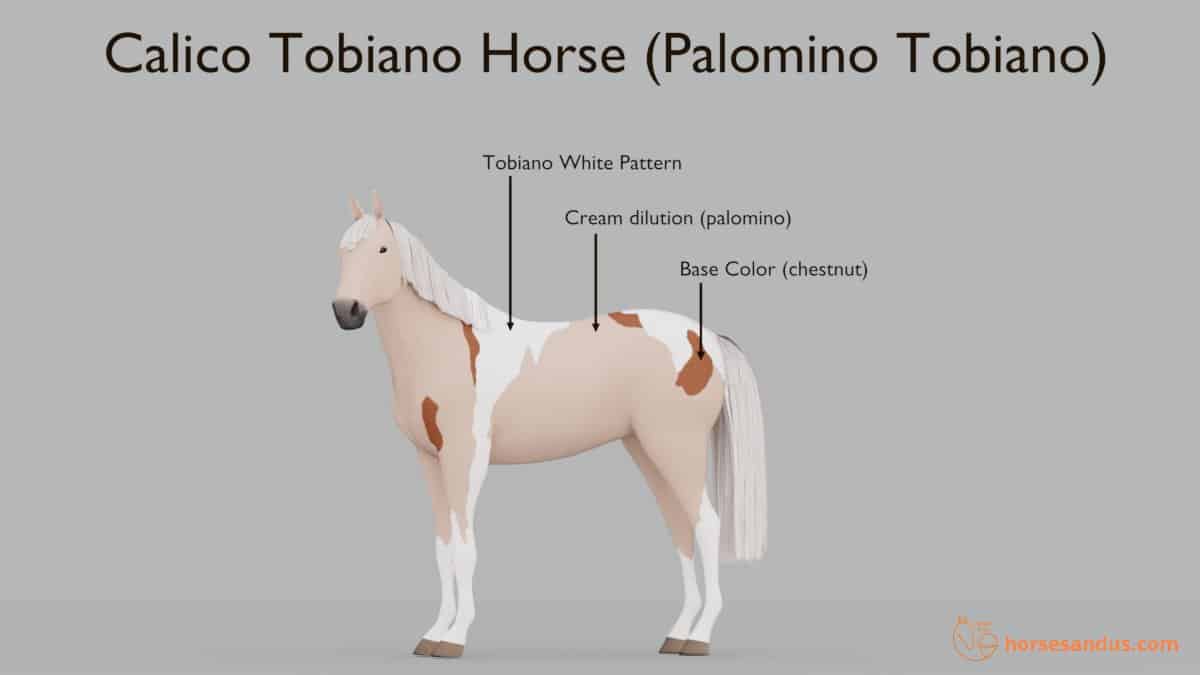
Origin Of The Name “Tobiano”
One interesting fact is the origin of the name Tobiano, which dates back to an event in Argentina in the 1800s.
The event was the rescue of Buenos Aires by General Tobias. Many of his troops were mounted on Tobiano spotted horses. So the Tobiano pattern was associated with these troops and therefore named after the General (Tobias) who was leading them.
Before the arrival of General Tobias to Argentina, the tobiano pattern did occur but was very rare, so it was grouped with all other white patterns under the name Overo.
Other Names Used For Tobiano Horses
Tobiano horses are often referred to by other names.
Piebald and Skewbald
Piebald and skewbald are both terms often used to describe white patterns on a colored horse. These terms apply to Tobiano since it is a white pattern.
Piebald is a horse with white patterns on a black base coat.
Skewbald is a horse with white patterns on a non-black coat, such as chestnut, bay, palomino, buckskin, dun, and so on. That is, on any coat color (base or diluted) other than black. A skewbald on a bay coat is also called tricolored because there are three colors: white, brown, and black.

Pinto and Paint
Both Pinto and Paint refer to horses with white patterns and any other color (black, bay, chestnut, or any dilution like, for example, palomino).
The difference is that a Pinto horse can be from any breed, whereas a Paint horse refers to a specific breed with this name.
What is the Difference Between A Tobiano And Overo?
The Tobiano pattern display is the inverse of the Overo pattern and can also be differentiated by the following characteristics.
| Characteristic | Tobiano | Overo |
|---|---|---|
| Spotting location | White areas across the topline extending down vertically. | White areas rarely cross the topline. |
| Spotting edges | White spots have smooth and rounded edges. | White spots have jagged and sometimes roaned edges. |
| Legs | Usually colored. | Usually white. |
| Mane and Tail | Usually have white mixed with color. | Usually colored. |
| Face | Typically the face is colored. But it can sometimes have face markings (star, snip, or stripe). | A bald-faced with a large mask of white extending over the eyes and across the entire head. |
| Eyes | Brown eyes but can occasionally have blue eyes. | Typically blue eyes. |
What is A Tovero Horse?
A Tovero horse (also called Tobero) is a mix of Tobiano and Overo white patterns.
The Tovero pattern can show the characteristics of both Tobiano and Overo patterns. The white patches can either be irregular or smooth, the face and legs can either be white or colored, the eyes can be brown or blue, and so on.
One of the typical characteristics of a Tovero horse is the “Medicine hat” – a white head with colored ears and forehead.
The additive effect of the Tobiano and Overo genes can at its most extreme result in a completely white horse.
The Genes Behind The Tobiano

The KIT gene in horses is responsible for many different white patterns. These white patterns can be grouped into four different variants of the Kit gene: Sabino(SB1), Tobiano(TO), Roan(RN), and Dominant White(W).
However, unlike the other spotting patterns caused by changes in the KIT gene’s DNA sequence, the Tobiano is instead associated with a chromosome inversion very close to KIT. Consequently, this impacts the function of the KIT gene, leading to the production of the Tobiano white pattern.
So this means that although Tobiano is not technically an allele of the KIT gene, it will always be linked to KIT, and so for practical purposes, it is considered a KIT allele.
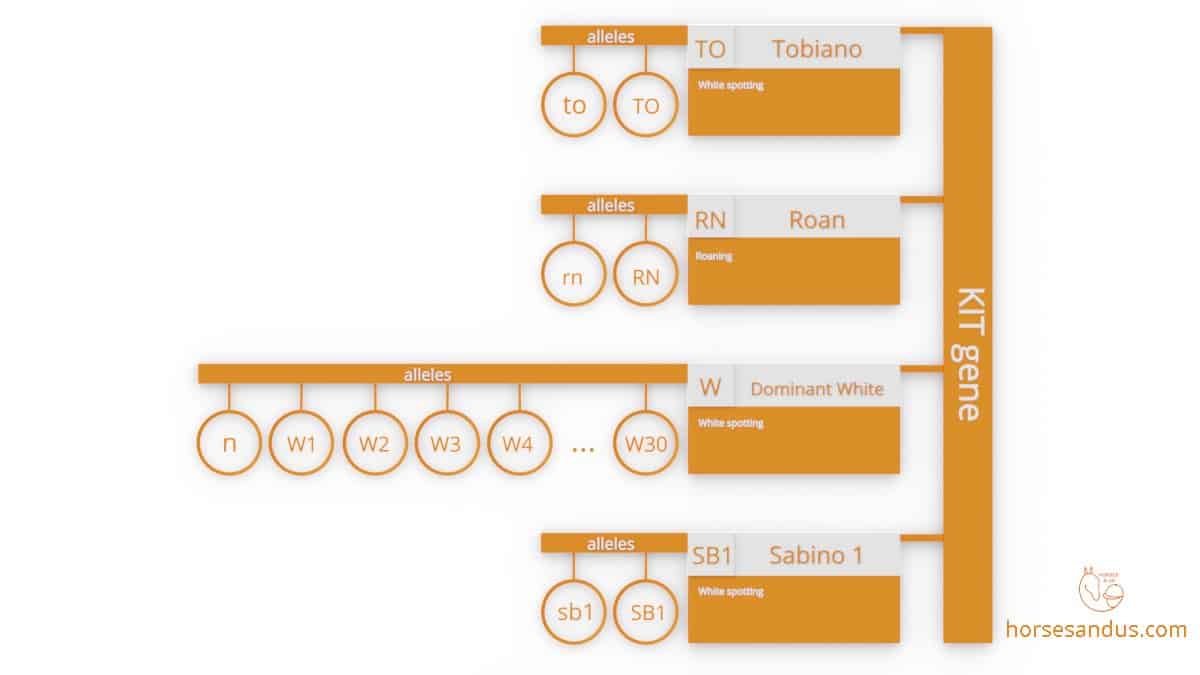
The Tobiano pattern is represented by the symbol TO, which is also used to represent the dominant allele. The recessive allele is represented by the lowercase symbol to.
Since TO is a dominant allele, it will be expressed both in the homozygous state (TO/TO) and the heterozygous state (TO/to).
Homozygous (TO/TO) horses are indistinguishable from heterozygous (TO/to) horses. However, the homozygous Tobiano will frequently present the “ink spots”, which only rarely appear in the heterozygous state.
Horses that do not have the TO allele (to/to) will not manifest the tobiano pattern.
Tobiano genes inheritance
Tobiano is inherited as a Simple Dominant. This means that if a horse is Tobiano, then at least one of the parents must have been Tobiano as well.
- TO – dominant allele
- to – recessive allele
- to/to the horse will not have Tobiano white pattern
- TO/to heterozygous, Tobiano. The horse will have a typical Tobiano pattern
- TO/TO homozygous Tobiano. The horse will have a typical Tobiano pattern and frequently having also “ink spots.”
Using the following Punnett Squares we can see the possible outcomes for foals based on different genotypes of the parents.
Combinations of white patterns from KIT gene
Since Sabino(SB1), Dominant White(W), Tobiano(TO), and Roan(RN) are all white patterns produced by the same KIT gene, only two can be present in a horse (one from the sire and another from the dam).
So, for example, we can have genotypes with only the Tobiano allele TO/TO or TO/to or genotypes that cross different traits in the KIT gene, like, for example, TO/SB1, TO/W1, or TO/RN.
This also means that if a horse has two KIT gene patterns, it will pass one or the other to its offspring but never both.
Adding Layers Of Other White Pattern Genes
However, horses can additionally carry other white pattern genes, like Splashed White and Frame Overo, because these white patterns are produced by other genes.
In conclusion, it is possible to add successive layers of white patterns, as long as each layer is caused by a different gene.
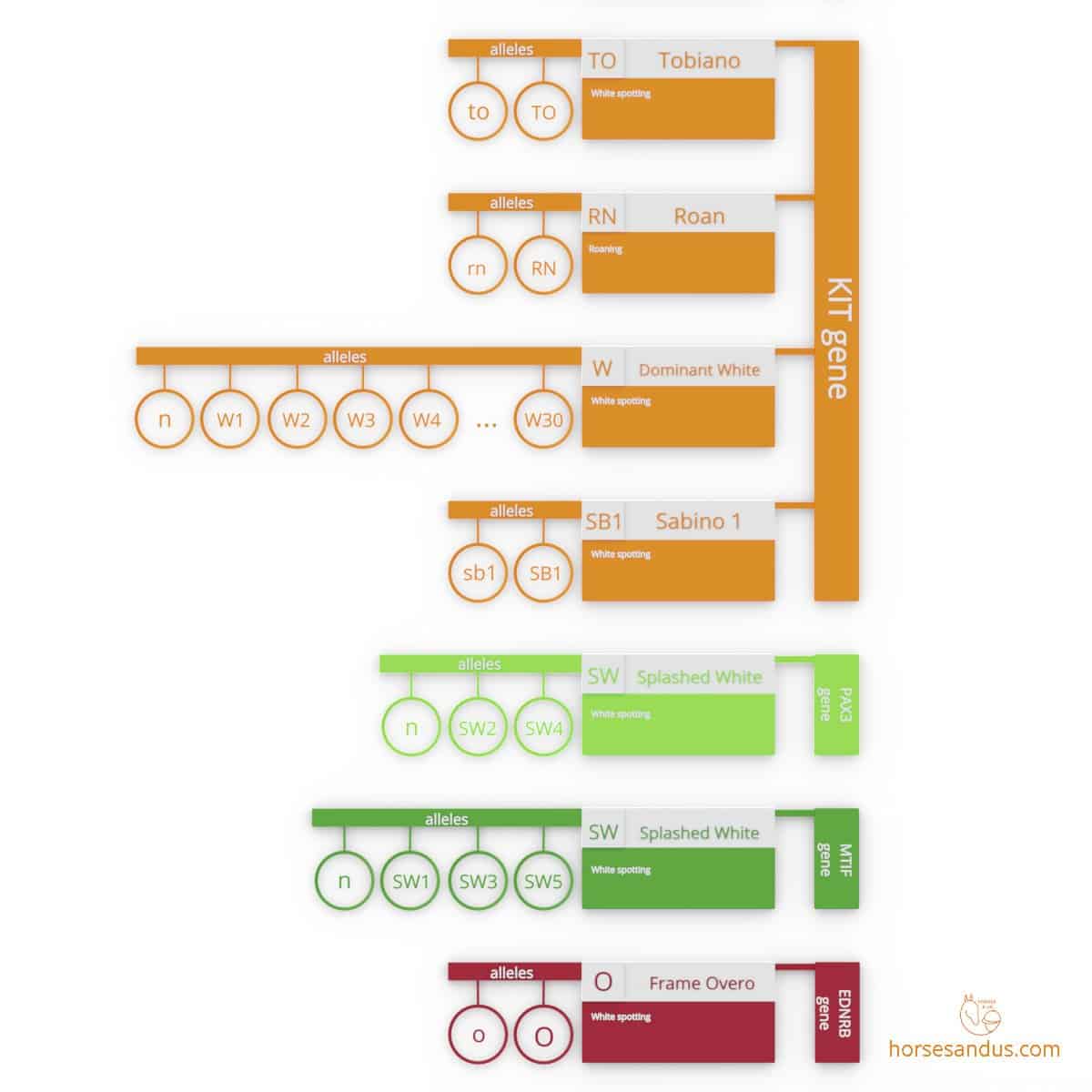
Breeds Where We Can Find The Tobiano Pattern
Considering that many breeds from around the world carry this pattern, we can conclude that this mutation must have existed for a long time.
In fact, some recent tests of DNA samples of ancient horses revealed that the tobiano gene existed in horses that lived approximately 3500 years ago.
The Tobiano pattern is very common in the Gypsy breed and American Paint Horse.
It can also be found in the Dutch Warmblood, American Saddlebred, Tennessee Walking horse, Missouri Fox Trotter, Paso Fino, Icelandic, Shetland, Miniature, Trakehner, Pottok, and Mongolian pony.
Further Reading
If you would like to learn more about horse colors and white patterns, you may want to read the following books, available on amazon.
The links below that lead to products on Amazon are affiliate links and I earn a commission (with no additional cost for you) if you make a purchase.
The following books are an introduction to horse colors and white patterns which are full of images and very easy to understand.
The Equine Tapestry: An Introduction to Colors and Patterns The Ultimate Guide to Horse ColorsA more technical book about horse colors, but still very easy to understand.
Equine Color GeneticsSources
Article from Color Genetics.info
Article from Animal Genetics UK
Equine Color Genetics 4th Edition by D- Philip Sponenberg



